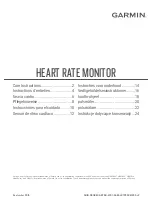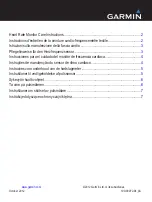
Section 13: Microprocessor Computer and Control –Theory of Operation
13-3
13.2.2 Microcontroller Signals
The battery and microcontroller have two signals that connect directly with each
other, EARLY
WARNING and PS OFF. The battery circuits generate an
EARLY WARNING signal to the microcontroller that the power is going down
within 100 millisecond. This EARLY WARNING signal could be due to the
power On/Standby switch being depressed or from the battery voltage getting too
low. The signal is connected directly to INTERRUPT 5
and INTERRUPT 7.
The software will save any information it must save and finish its housekeeping
before sending the PS OFF signal back to the battery circuits.
13.2.3 Membrane Switch and LED Signals
13.2.3.1 Membrane Switches Connected to the Power Supply
The power supply circuit connects directly with the ON/Standby switch and the
two LEDs on the membrane switch. The On/Standby switch goes directly from
the membrane switch to the power supply board. This is to allow powering up
when off. Another switch, the Alarm Silence switch also goes to the battery
circuit. Unlike the On/Standby switch, this switch also goes to the
microcontroller.
13.2.3.2 Power Supply Generated LED Signals
The power supply circuits generate two LED driving signals, one that indicates
that the AC mains is connected, and one that indicates that the DC power is
connected. When the AC Mains
LED is being driven on, a high voltage level
goes to the 386EX port 1 bit 6 as the AC mains input status bit. When the LED
is off, the signal is a logic low. The software will interpret the signal levels so as
to tell whether the AC mains is connected or not. The same is true with the DC
connector. The signal driving the DC LED goes to port 1, bit 7. This indicates
the DC power status.
13.2.4 Battery Signals to the A/D Converter
The battery voltage and temperature signal is sent to the main board where it is
buffered by an amplifier circuit that converts it to a signal within the 0-5 volts
range of the A/D converter. The BATTSNS
+
signal is sent directly to the Main
Board and is divided by two by a resistor divider circuit on the positive input to
the amplifier. The amplifier has a gain of two, which brings the signal back to
its original signal level and then it is resistor-divided to the 0-5 volts range for
the A/D converter.
13.2.5 Sync/Alarm 50kHz Signal
The power supply needs a 50 kHz signal to synchronize its own internal
operation and to keep the alarm from sounding if the watch dog timer (WDT)
times out. The 50 kHz signal is “anded” with the watchdog timer (WDT), and if
the WDT should time out, the power supply circuit will sound the alarm and shut
down the Main Board.
Summary of Contents for NELLCOR NPB-4000
Page 66: ... THIS PAGE INTENTIONALLY LEFT BLANK ...
Page 68: ...Section 7 Spare Parts 7 2 Figure 7 1 NPB 4000 C Top Assembly Drawing ...
Page 70: ...Section 7 Spare Parts 7 4 Figure 7 2 NPB 4000 C Front Case Assembly Diagram Sheet 1 of 2 ...
Page 72: ...Section 7 Spare Parts 7 6 Figure 7 3 NPB 4000 C Front Case Assembly Diagram Sheet 2 of 2 ...
Page 74: ...Section 7 Spare Parts 7 8 Figure 7 4 NPB 4000 C Rear Case Assembly Diagram Sheet 1 of 2 ...
Page 76: ...Section 7 Spare Parts 7 10 Figure 7 5 NPB 4000 C Rear Case Assembly Diagram Sheet 2 of 2 ...
Page 78: ...Section 7 Spare Parts 7 12 Figure 7 6 NPB 4000 C Power Supply Heat Sink Assembly Diagram ...
Page 80: ... THIS PAGE INTENTIONALLY LEFT BLANK ...
Page 96: ... THIS PAGE INTENTIONALLY LEFT BLANK ...
Page 114: ... THIS PAGE INTENTIONALLY LEFT BLANK ...
Page 140: ... THIS PAGE INTENTIONALLY LEFT BLANK ...
Page 180: ... THIS PAGE INTENTIONALLY LEFT BLANK ...
Page 192: ... THIS PAGE INTENTIONALLY LEFT BLANK ...
Page 208: ... THIS PAGE INTENTIONALLY LEFT BLANK ...
Page 210: ... THIS PAGE INTENTIONALLY LEFT BLANK ...
Page 211: ...Section 17 Drawings 17 3 Figure 17 1 MP 205 PCB Schematic Sheet 1 of 2 ...
Page 212: ...Section 17 Drawings 17 5 Figure 17 2 MP 205 PCB Schematic Sheet 2 of 2 ...
















































